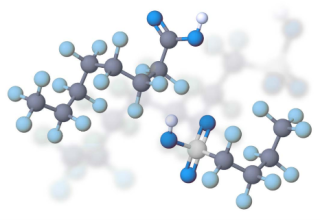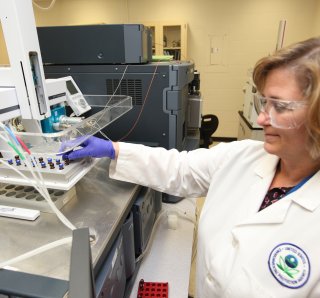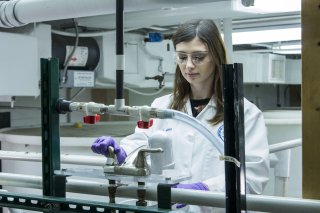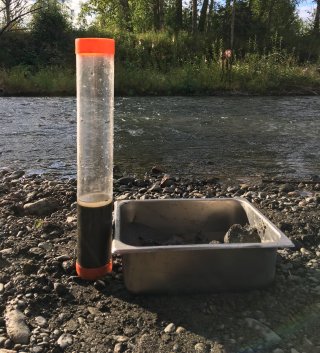Water Research on Per- and Polyfluoroalkyl Substances (PFAS)

Per- and polyfluoroalkyl substances (PFAS) are a complex class of chemicals that historically have been used in industry and consumer products and continue to be widely used today. PFAS can be persistent in the environment and the human body. PFAS contamination of water is a significant issue in the United States and a high priority for the EPA.
EPA research on PFAS in water sources focuses on developing tools for evaluating and managing risks from PFAS, such as the development of analytical methods for measuring occurrence; drinking water and wastewater treatment approaches for removal; residual stream treatment and management; and identifying and characterizing PFAS sources to design treatment management approaches.
EPA has a range of research on PFAS that is not limited to water resources. For more information about all of EPA's PFAS research, please visit Research on PFAS or EPA’s primary PFAS webpage.
Analytical Methods for PFAS in Drinking Water, Wastewater, and Environmental Samples

EPA’s research includes the development of analytical methods for measuring large groups of PFAS in water and water-related samples. Total organic fluorine and total oxidizable precursors are analytical methods that help researchers determine whether a PFAS might be present by looking at certain components and precursors of PFAS. Traditional targeted methods require researchers to know what chemicals they are looking for, which can be time consuming and labor intensive. Scientists are building on existing analytical methods and also developing non-targeted methods used to analyze and characterize thousands of unknown and new PFAS.
Learn more about PFAS analytical methods development and sampling research.
Science Matters Story: Non-Targeted Analysis
Today, researchers can rapidly characterize thousands of never studied chemical compounds in a wide variety of environmental, residential, and biological media. This approach is called non-targeted analysis. Read about how researchers from EPA and North Carolina State University used the non-targeted approach to understand the impact of industrial discharges in one waterbody.
Treatment Technologies and Processes for Removing PFAS from Community Drinking Water

EPA’s research on drinking water treatment technologies for PFAS focuses on collecting existing treatment data from the literature and combining it with results from additional laboratory studies on PFAS removal. These studies use a wide variety of technologies, including granular activated carbon, ion exchange, and membranes. EPA researchers evaluate, model, and optimize treatment technologies, including treatment at the water treatment plant and at the point of use, such as a faucet.
EPA’s research is conducted at multiple scales, including benchtop studies in the laboratory, pilot-scale studies both in the laboratory and in the field, and full-scale treatment studies at municipal drinking water treatment plants. EPA research focuses on a range of drinking water system sizes, such as drinking water systems serving large cities with populations of more than 10,000 people, to very small communities with populations of less than 100 people that may use point-of-use or point-of-entry systems. Research focuses on issues that impact systems with technical, financial, and managerial capability limitations.
Science Matters Story: Effectiveness of Point-of-Use Filters for Reducing PFAS
To help homeowners make an informed decision when trying to reduce PFAS in their drinking water, EPA researchers conducted studies on several off-the-shelf, commercially available technologies, including granular activated carbon, reverse osmosis, and ion exchange treatment systems to determine if they were capable of reducing PFAS levels in drinking water. Read about their point-of-use filters research results and how different filtration systems fared.
How to identify drinking water filters certified to reduce PFAS
Related Research
PFAS Sources and Occurrence in Water

Possible PFAS sources in water can include industrial and hospital wastewater, landfill leachate, or washing facilities. Knowing the sources of PFAS in water resources is critical for developing cost-effective approaches to managing PFAS contamination.
EPA’s research focuses on building and improving models to predict the fate and transport of PFAS in water, assess exposure pathways and risks, and identify and characterize PFAS sources and concentrations. Researchers apply these models and analyses to reduce possible exposures to PFAS and improve treatment technologies.
Related Research
- Wastewater Research
- Wastewater Contaminants Research
- Stormwater Management Research
- Alternative Water Sources Research
Disposal and Destruction of PFAS
PFAS is difficult to treat in water and requires effective and economical solutions. This research focuses on the development and advancement of cost-effective, high-efficiency processes to remove PFAS from wastewater, stormwater, industrial and process wastes, leachates, biosolids, and residual streams.
Science Matters Story: Exploring Technology to Destroy PFAS
PFAS molecules are made up of a chain of linked carbon and fluorine atoms. Thanks to recent trials, EPA researchers may have found an effective method of breaking this chain link of carbon and fluorine to destroy PFAS—called Supercritical Water Oxidation (SCWO). Read about their trials to test the efficacy of SCWO technology on PFAS destruction.
Models, Tools, and Methods
- EPA Science Models and Research Tools (SMaRT) Search
- Drinking Water Treatability Database (TDB)
- Environmental Technologies Design Option Tool (ETDOT)
- Water Treatment Models
- Drinking Water research methods
- PFAS methods and guidance for sampling and analyzing water and other environmental media-Technical Brief (pdf)
- PFAS Reviewing Analytical Methods Data for Environmental Samples-Technical Brief (pdf)
